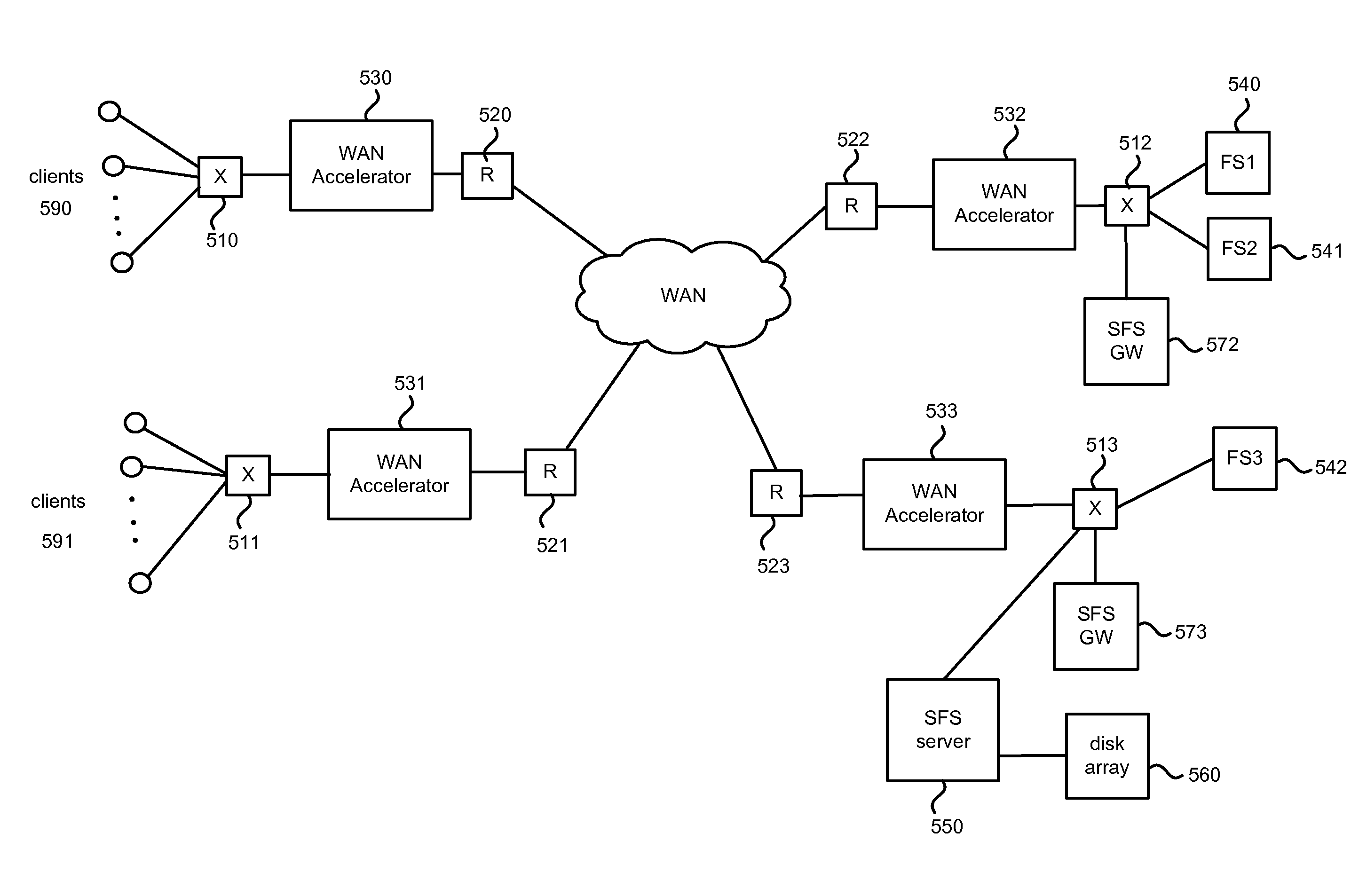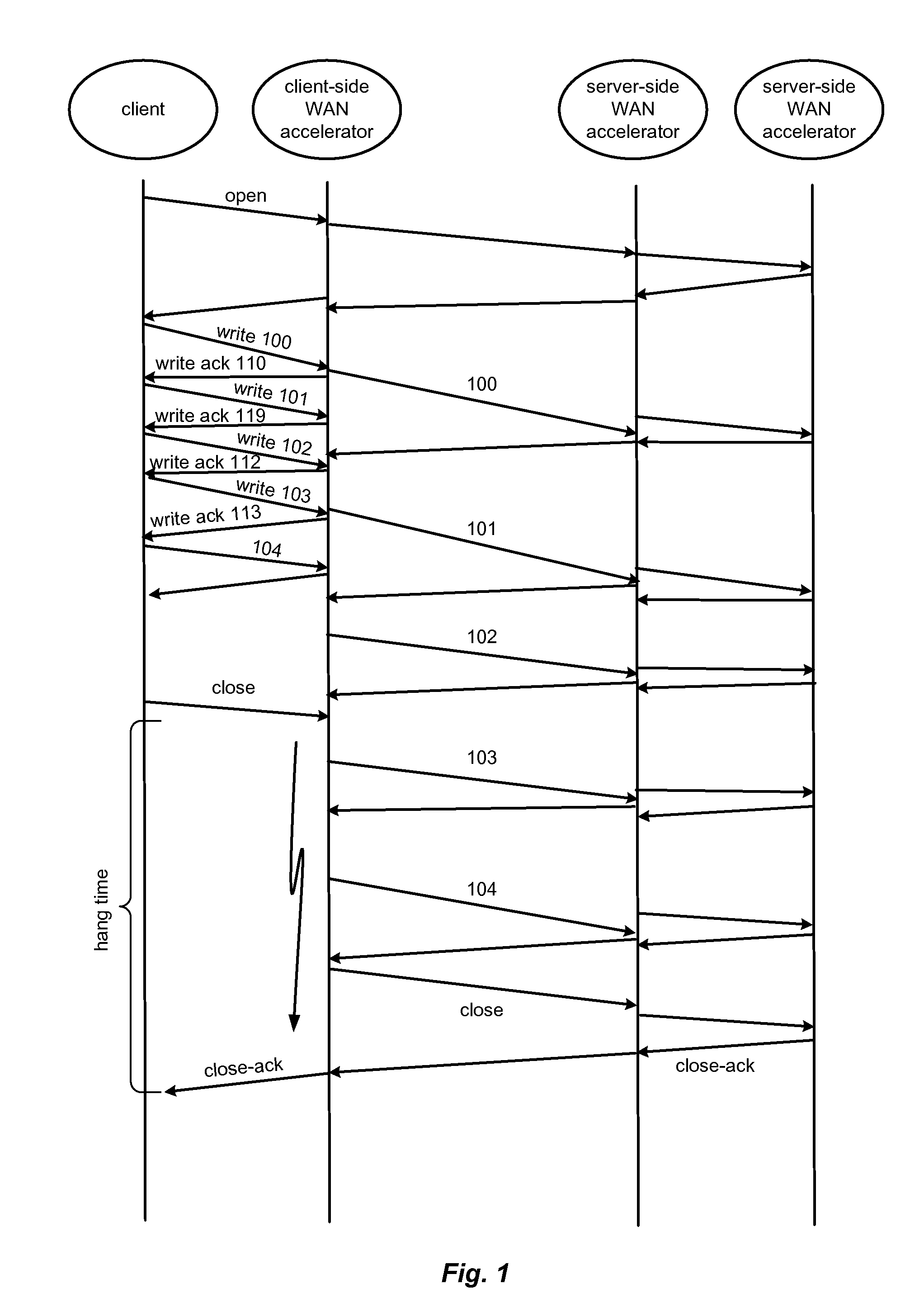By contrast, WANs often have lower bandwidths and higher latencies than LANs, and often provide limited controls to the
enterprise IT operator because WAN links often
traverse networks that are tightly controlled by a
service provider thereby preventing the
enterprise IT operator from modifying or introducing components within the closed, service-provider network.
This access most often has very poor
throughput when compared to the performance across a LAN.
Similar design problems exist for other network services, such as e-mail services, Web services, computational services,
multimedia, video conferencing,
database querying, office
collaboration, etc.
Otherwise, slow performance for file access can negatively
impact a user's
work productivity as time is wasted waiting for files to save and load, or waiting for application pauses while an application performs file I / O, and so forth.
The two primary impediments to
application protocol performance over a WAN are typically high
delay (or latency) and limited bandwidth.
With latency, however, lower latency is not available from a
network service provider at any price, using known laws of
physics, if it would require communications to occur at speeds faster than the
speed of light.
High network latency particularly slows down “chatty” applications, even if the actual amounts of data transmitted in each transaction are not large.
Adding bandwidth (or compressing data) does not improve the throughput of these protocols / applications when the round-trip time exceeds some critical point and once the latency reaches that critical point, throughput decays quickly.
Of course this is the most direct solution, but it is not always the most effective approach.
First of all, contrary to popular belief, bandwidth is not free and the costs add up quickly for large enterprises that may have hundreds of offices.
Second, as described above, adding bandwidth does not necessarily improve throughput.
Third, in some places adding more bandwidth is not possible, especially across international sites, in remote areas, or where it is simply too expensive to justify.
In some cases, compression might add to the latency, if time is needed to compress data after the request is made and time is needed to decompress the data after it is received.
This may be able to be improved if the data can be compressed ahead of time, before the request is made, but that may not be feasible if the data is not necessarily available ahead of time for compression, or if the volume of data from which the request will be served is too large relative to the amount of data likely to be used.
This is a reasonable thing to do, but the effectiveness is limited.
When performance is limited by network latency, compressing the underlying data will have little or no
impact on application performance.
While helpful, it is not enough to dramatically change performance if the amount of data being sent is large or similar data is sent repeatedly, perhaps over longer time scales.
Because it operates solely on individual packets, the performance gains that accrue are limited by the ratio of the
packet payload size to the packet header (since the packet header is generally not compressible using the described technique).
This configuration can be difficult to achieve, and may be impractical in certain environments.
Also, by caching network packets using a relatively small memory-based cache with a first-in first-out replacement policy (without the aid of, for instance, a large disk-based backing store), the
efficacy of the approach is limited to detecting and exploiting communication redundancies that are fairly localized in time.
Finally, because this approach has no ties into the applications or servers that generate the (redundant) network traffic, there is no ability to anticipate where data might be used and pre-stage that data in the far-end cache providing potential further acceleration and optimization of network traffic.
The challenge with this kind of approach is the basic problem of managing the ever-exploding amount of data, which requires scaling up storage, application and file servers in many places, and trying to make sure that the files people need are indeed available where and when they are needed.
Moreover, these approaches are generally non-transparent, meaning the clients and servers must be modified to implement and interact with the agents and / or devices that perform the replication function.
One problem that must be overcome when deploying proxies is that of directing
client requests to the proxy instead of to the destination
server.
In addition, this type of deployment requires that all clients must be explicitly configured and that can be an administrative burden on a
network administrator.
Where each proxy must be explicitly configured with indications of the pairs to which it belongs and to the identity of the other members of those pairs, the administrative burden on a
network administrator might well make some operations infeasible if they require proxy pairs.
Caching also provides some help in mitigating both latency and bandwidth bottlenecks, but in some situations it does not help much.
Caching has its difficulties, one of which is that the data might change at the source and the cache would then be supplying “stale” data to the requester.
Another problem with caching is that the original source of the data might want to track usage of data and would not be aware of uses that were served from the cache as opposed to from the original source.
In some cases, an
Internet service provider might operate the cache remote from the browsers and provide cached content for a large number of browsers, so a
Web server operator might even miss unique users entirely.
Additionally, the mechanism underlying Web caching provides only a loose model for consistency between the origin data and the cached data.
This means that cached Web data can occasionally become inconsistent with the origin server and such inconsistencies are simply tolerated by
Web site operators, service providers, and users as a reasonable performance trade-off.
Unfortunately, this model of loose consistency is entirely inappropriate for general client-server communication like networked file systems.
Such systems have limitations in that they are tied to file systems and generally require modification of the clients and servers between which responsiveness is to be improved.
Furthermore, the hashing scheme operates over blocks of relatively large (average) size, which works poorly when files are subject to fine-grained changes over time.
Finally, the scope of the LBFS design is limited to a
network file system protocol whereby the LBFS hashing scheme is not shared with other data or network services.
The approach, however, does not provide details for how client writes would be handled and defers such mechanism to future work.
Also, like LBFS, the scope of the CASPER design is limited to a
network file system protocol whereby the hashes used in file receipts are not shared with other data or network services.
The CASPER design is also limited to a configuration wherein whole-
file caching is carried out on the
client system and the client-side
file system is configured explicitly to intercommunicate with the local CASPER implementation.
Moreover, CASPER has no mechanisms to optimize other operations like
directory lookups,
directory modifications, file creation and deletion, and so forth.
The primary challenge is to provide a consistent view of a file to multiple clients when these clients read and write the file concurrently.
When consistency mechanisms are combined with network caching, a great deal of complexity arises.
This approach is burdened by a great deal of complexity in managing consistency across all the caches in the
system.
Moreover, the
system's
concurrency model assumes that all file activity is managed by its caches; if a client modifies data directly on the server, consistency errors could arise.
Also, its ability to overcome network latency for client accesses to data that is not resident in the cache is limited to performing file-based read-ahead.
For example, in NFS, a client that opens a file must look up each component of the path (once per round-trip) to ultimately locate the desired file
handle and file-based read-ahead does nothing to eliminate these round-trips.
Unfortunately, this approach presumes the existence of a cache and thus entails the complexities and difficulties of cache coherency.
While compound operations and delegations can be exploited to enhance
wide area file server performance, they have limited impact.
In particular, while compound operations are potentially helpful, in practice it is difficult for a client implementation to utilize them extensively enough to impact WAN performance without changing the way an application interfaces to and interacts with the
file system and making such changes is, in general, not practical.
Likewise, while delegations can also be helpful, they still rely upon transporting the data from the file server to the client over the network, which may be a costly and performance impairing operation in many environments.
In short, while recent improvements to
file system design are in general helpful to wide-area performance problems, they fall short of solving such problems comprehensively.
For example, there still may remain duplication of effort, such as when a file is read multiple times by one or more clients.
Another problem might occur with redundant transformations.
Yet another problem with existent file server protocol designs is that they presume a tight
coupling between a file and its underlying data and this
coupling imposes certain constraints on file server network protocols.
When the network has high latency or inefficient bandwidth, these sorts of
data operations can be highly inefficient and burdensome to the user.
This overall issue is sometimes called the “cold write performance” problem because write performance suffers for “cold” data, where so-called cold data is data that is not currently in the WAN accelerators' segment stores.
The cold write performance problem is illustrated in FIG. 1, which occurs when the client writes new data to a file and immediately closes that file.
Otherwise, if the client-side WAN accelerator acknowledged the close request before this occurred, the file server protocol
semantics could be violated and conditions could arise under which the client had received a successful acknowledgment of the writes and the close, but the data never made it safely onto
stable storage (e.g., because the file server crashes after the close is acknowledged but before the data is written to disk).
When there are many new segments to be transmitted over a possibly bandwidth-constrained link, this operation can take a non-trivial amount of time.
Thus, the client can perceive a noticeable
delay while the close is waiting on the writes to complete.
Another challenge for WAN accelerators with regard to file server protocols is the so-called CAP theorem.
In general, with respect to file server protocols, WAN accelerators favor consistency over availability and do not allow a client to read or modify a file in the face of a
network partition.
However, this mechanism works only for files that are presently open when the
network partition arises.
If a client at a remote site wishes to access a file while a
network partition exists, a WAN accelerator has no means by which to allow such access to occur without being able to contact the origin file server.
Unfortunately, while many of the above techniques solve some aspects of WAN performance and
file storage and serving problems, they still have some shortcomings and several challenges remain in the way that existing WAN accelerators and file servers intercommunicate.
 Login to View More
Login to View More  Login to View More
Login to View More 


